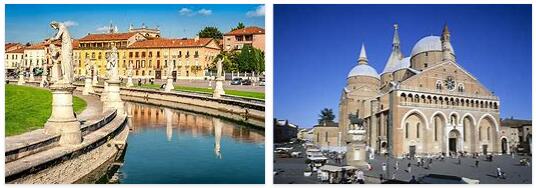Bologna
The Torri Gentility are considered to be the symbol of Bologna. Of the originally around 100 medieval towers, 17 still exist today, and many of them are reminiscent of the leaning tower of Pisa in their inclination. The almost 100 meter high Torre degli Asinelli offers a breathtaking panoramic view over the city.
In the center of the old town is the Piazza Maggiore with the famous Neptune Fountain from the early Renaissance. The view here is dominated by the huge Gothic basilica of San Petronio. Begun at the end of the 14th century, the building was originally intended to be the largest church in Christendom. Although the facade has remained unfinished to this day, the interior of the basilica impresses with magnificent frescoes and two of the oldest organs in Italy. A midday line can also be admired here, laid out according to plans by the astronomer Giandomenico Cassini.
One of the oldest churches in Bologna is the Basilica di Santo Stefano, part of a monastery complex in the historic city center. The Marian shrine of the Madonna di San Luca is located on a hill above the city. A trip to this pilgrimage church is not only popular with pilgrims – from up here you also have a wonderful view of the city and the countryside.
Incidentally, Bologna is not only an El Dorado for study travelers, but also for fans of motorsport: Resounding names such as Maserati, Ducati, Ferrari and Lamborghini make hearts beat faster. They are all at home here or in the immediate vicinity and attract visitors with museums, classic car exhibitions and factory tours.
Alberobello
Alberobello in the Apulia region in southwest Italy is much more than a real insider tip. If you are on holiday in the region, you should pay a visit to the 11,000-inhabitant town. Alberobello is particularly famous for its numerous white houses with the characteristic gray conical roof, the so-called trulli, in the historic city center. That is why the town, which is a UNESCO World Heritage Site, is also called Trulliland. Most of the more than 1,000 historic trulli are still inhabited today. The trulli are characterized above all by a special structural statics from the 14th century. The center of Alberobello is characterized by numerous narrow streets and many small shops and cozy cafes.
Excursion destinations and picturesque landscapes are well worth seeing
In addition to the trulli, which are known far beyond the Italian borders, there are other sights in Alberobello. The church of St. Anthony should not be missed, nor is the city museum, which is located in a trullo from the 18th century. There are also numerous excursion destinations in the vicinity of Alberobello – including the largest stalactite cave in Apulia, the Castellana Grotte. And the picturesque landscape around Alberobello is extremely attractive and worth seeing. The nature of Apulia is characterized, among other things, by dense forests and green vineyards. The attractive region can be explored through a well-developed network of bike and hiking trails.
Piazza del Duomo, Parma
If you visit Parma, you will not miss the Piazza del Duomo. The huge square in the heart of the northern Italian city is dominated by the large cathedral Santa Maria Assunta and the baptistery, the two most important landmarks of the city. The two impressive historical buildings on Domplatz are famous far beyond the Italian borders and are among the most photographed sights in the city. The completely car-free square is one of the most beautiful places in the world and is the pride of Parma.
Sights around the Piazza del Duomo
Both the cathedral with the impressive dome and the octagonal baptistery made of pink marble were built between the eleventh and thirteenth centuries in the Romanesque-Gothic style. Numerous valuable works of art and beautiful frescoes can be viewed inside both buildings. In the vicinity of the Piazza del Duomo there is also the Church of San Giovanni Evangelista with the associated monastery and the Museo Camera di San Paolo. Around the Piazza del Duomo there are also many small and large restaurants as well as various traditional arcades with small shops. A long stroll across the Piazza del Duomo is well worth it. In this historical ambience in the center of the city, you actually feel as if you have been transported back to the Romanesque period.
Padua
Padua is one of the oldest cities in Italy. The university city is located in the west of the Veneto region in the north of the country. Padua offers numerous attractions for all ages and tastes. Even a short walk through downtown Padua reveals many historical buildings. The city’s most famous attraction is the 13th century Basilica of Saint Anthony, which is one of the most visited attractions in Italy. The cathedral of Padua, which is well worth seeing, should not be missed when visiting the city of 200,000. The Prato della Valle is one of the most beautiful places in Europe. The historic Caffè Pedrocchi, the most famous café in the city, should definitely be visited in Padua.
Numerous thermal baths in the region
A visit to the Padua Planetarium, which is located just outside the city center, also promises a lot of excitement. Animal and plant lovers will get their money’s worth, especially in the botanical garden.
In the footsteps of Galileo Galilei
The most famous son of the city of Padua is Galileo Galilei. The world-famous physicist and astronomer, who was professor at the University of Padua from 1592 to 1610, is still remembered by numerous monuments throughout the city.
